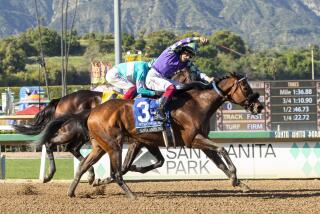Invisible Ink Has Already Scored a Remarkable Rally
- Share via
LOUISVILLE, Ky. — “I was in Vietnam,” John Fort was saying. “Like any person my age, I’ve seen creatures that were dying, whether it was a bird or a dog or a person.
“I don’t think there’s anyone who doesn’t recognize death when they see it, a creature that is beyond [hope]. There’s everything about them that says this thing is dying.
“I’ve never seen a creature sink this low. This horse was dead.”
Dead but not buried.
Forget Point Given’s romp in the Santa Anita Derby. Forget Congaree’s victory in the Wood Memorial. Forget the way Millennium Wind won the Blue Grass Stakes or how Monarchos finished first in the Florida Derby.
Forget all the other stories about all the other horses in Saturday’s Kentucky Derby.
Invisible Ink can top every one of them.
They defeated mere mortals. He beat death itself.
Fort, who bought the colt for $105,000 at Keeneland’s yearling sale in September 1999, was telling the story the other day outside trainer Todd Pletcher’s barn.
No matter how many times he tells it, it never fails to amaze him. Even now, a year later.
The story began in March of last year, when Invisible Ink was a 2-year-old, already broken but just starting his race training at Bryan Rice’s Woodside Ranch in Fort McCoy, Fla.
“He was at a stage where he was galloping a mile and half or a mile and three-eighths every day,” Fort said.
But one day Fort got a phone call from Rice.
“I just wanted to let you know that I’m taking Invisible Ink out of training for a couple of days,” Fort quoted Rice as saying. “He seemed to nick himself in the paddock and got a little filling in that ankle and I’ve given him some [Butazolodin, an anti-inflammatory drug] and some antibiotics.”
Fort said there was “no tone of concern” in Rice’s voice.
A week later, Rice called again.
“I’m not satisfied the way this thing’s going,” Rice told Fort. “It doesn’t look like it’s responding the way it should. I’m going to take him in to the clinic.”
That was the Peterson & Smith veterinary clinic in Ocala, Fla., where Invisible Ink came under the care of Dr. Carol Clark.
Initially, the veterinarians did not think Invisible Ink’s condition was life threatening and he was sent back to the farm after two days at the clinic.
But things went from bad to worse in a hurry. The horse was losing weight fast and ended up losing almost 400 pounds during its ordeal. It wouldn’t eat or drink and an endoscopic examination of its throat and stomach showed why.
“It was as if somebody had poured battery acid down this horse’s throat and just completely stripped the skin and ulcerated the horse to the point where he couldn’t even drink water because swallowing it was so painful,” Fort said.
“The poor thing . . . couldn’t pick his head up, and great globs of saliva would just drip out his mouth. It was the most pitiful thing I’ve ever seen in my life.”
Even today, the cause of the condition remains a mystery.
The most plausible theory is that, while his ankle was being treated, someone, meaning well, gave the horse too much Butazolodin, which can cause ulceration and to which some horses are allergic.
“Bute’s a pretty powerful medication, especially when taken orally,” Fort said.
“Finally it developed into colitis and the horse couldn’t eat or drink at all. And then the body functions broke down to the point where the blood protein levels had dropped so low that all the [intravenous] fluids we were giving him--his only source of sustenance--were flushing out into his body and he developed all this [swelling under the skin]. You could barely tell where his head and neck were.
“This horse had no hair. His immune system had broken down so much that we had to bathe him with antiseptic soap every day just to wash the pus and things running out of all the sores.
“We were giving him [blood] plasma at a rate of about $1,000 a day.”
The future looked bleak for Invisible Ink.
“We had permission from the insurance company to put him down,” Fort said.
But Fort is an owner whose love of horses is greater than his love of winning races. He would not give up on Inky, as the bay colt is nicknamed.
Instead, he and Clark held a two-hour conference call with veterinarian Robert Copelan in Atlanta, where Fort’s Peachtree Stable was founded in 1981.
Copelan came up with a plan to save Inky. Massive doses of an acid-blocker were used to treat the ulceration and Copelan suggested using buttermilk to restore the necessary bacteria to Invisible Ink’s digestive system.
It did the trick, and with Clark’s patience and perseverance, the colt regained its appetite.
“She spent literally days and nights with him, coaxing him to eat, holding literally one pellet of food in his mouth at a time,” Fort said.
The ordeal lasted roughly five weeks.
In the end, the battle was won. Invisible Ink regained all the lost weight by mid-July and made his racing debut at Aqueduct in October.
Now, the Kentucky-bred colt is at Churchill Downs, preparing for Saturday’s Derby.
More to Read
Go beyond the scoreboard
Get the latest on L.A.'s teams in the daily Sports Report newsletter.
You may occasionally receive promotional content from the Los Angeles Times.









